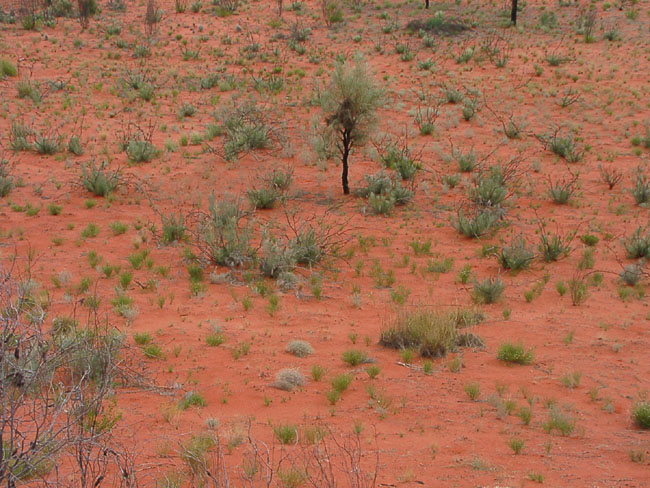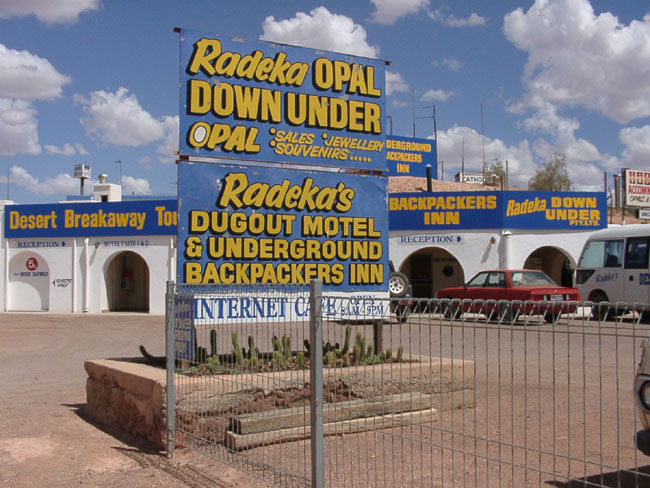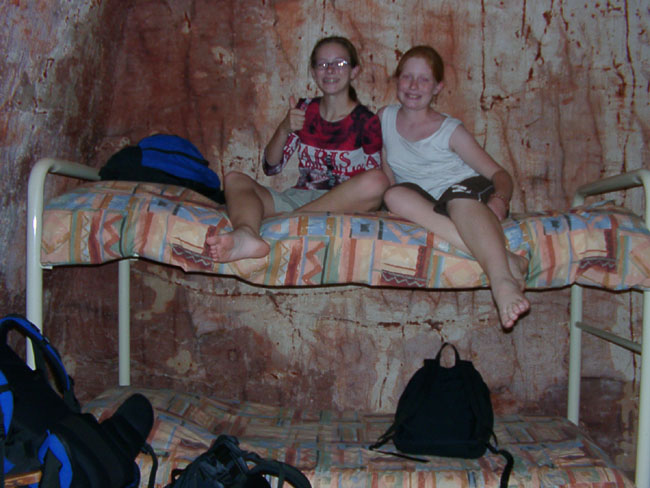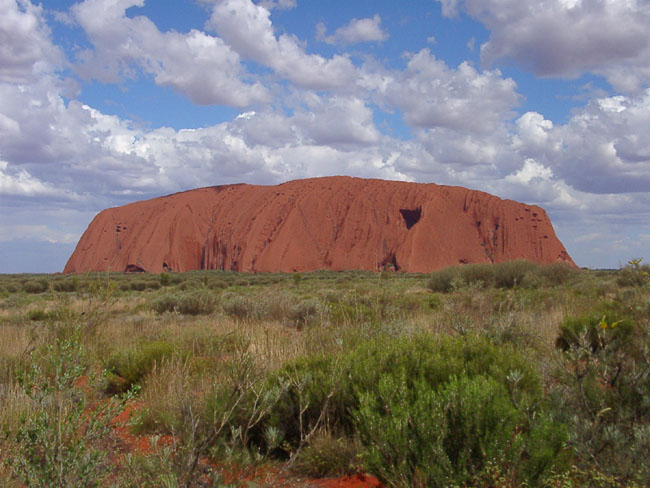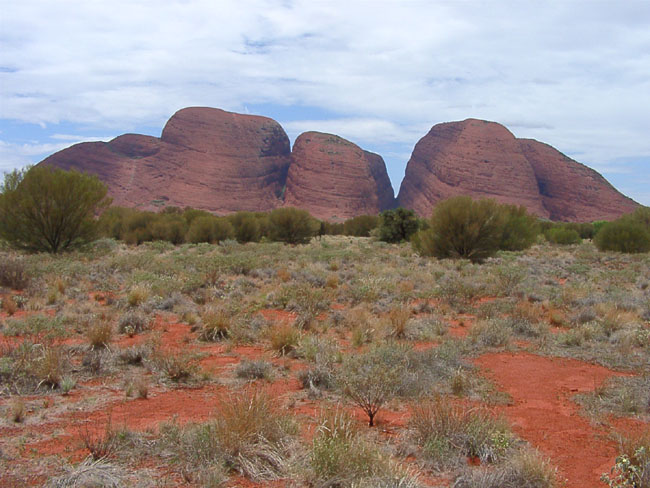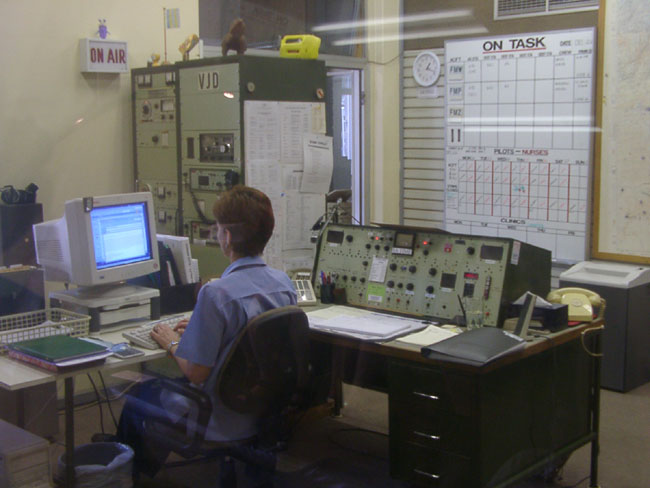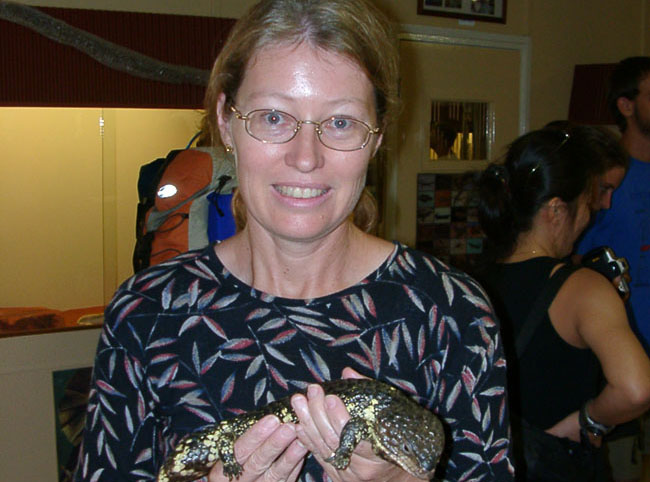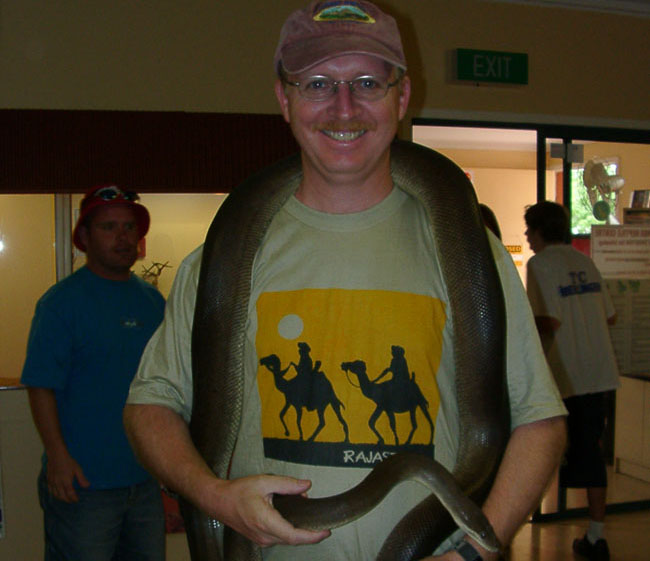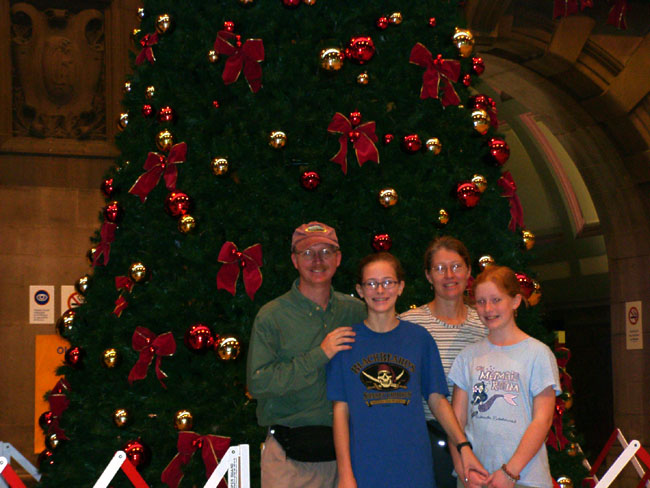| «Back to Previous Post |
Date: Tuesday, 23 December 2003 00:49 PST
Subject: Merry Christmas from the Red Centre
Captions for pictures:
1. A view of the soil at the “Red Centre” (nickname for the Outback)
2. The portion of Radeka’s Dugout Motel & Underground Backpacker’s Inn that’s above ground
3. A picture from within our underground room through a rock arch of Lauren and Kristen on the top bunk of their bunk bed
4. Ayers Rock, also known as Uluru
5. The Olgas (also known as Kata Tjuta) at Uluru – Kata Tjuta National Park
6. The (working, not a model) Command Center of the Royal Flying Doctors Service in Alice Springs
7. Sandy holding a lizard at the Reptile Park in Alice Springs
8. Darren holding a python at the Reptile Park in Alice Springs
9. A blue-tongued lizard with his mouth open at the Reptile Park in Alice Springs
10. A picture of the family in front of a Christmas tree in the Sydney Central Train Station taken a few days ago
22 December 2003 – Day #93
We are now in the dead center of the country – Alice Springs. It’s been in the 90’s and 100’s degrees F for the last week. And because of wet weather to the north, it’s a bit humid as well. The terrain in the Outback is a real surprise. We expected to see lots of nothing. While we’ve seen our share of barren desert, the Outback between Adelaide and Alice Springs has been quite varied. We’ve seen land that looks a lot like shots from Mars (red sand and rocks) all the way to rolling hills, with wild flowers, bushes, small conifers (pines) and in other places eucalyptus forests.
Our first stop after Adelaide was Coober Pedy. It is basically a mining town, supplying 90% of the world’s Opals. Starting about 25 miles outside of the city, you begin to see the trailings made by the mining operations. The town center itself is small – only a few blocks long. Some of the cars sport wooden signs that read “Explosives” on their roofs.
Because of the heat (often over 100 degrees F), about half of the population lives underground. Using techniques borrowed from the mining industry, these homes are built as a series of underground vaults. In fact, we stayed at one of these – Radeka’s Dugout Motel & Underground Backpacker’s Inn. Our room was about 30 feet underground. While only slightly larger than Saddam’s spider hole, it was comfortable and cool without the aid of air conditioning.
To get to our room, we followed two long flights of stairs down to a large vault. The entrances to the rooms were carved out of the rock at right angles to this main vault. Our room had a door, a double bed and two twin bunk beds plus a table carved out of the wall. About two-thirds of the rooms was simply an archway followed by a smaller vault containing two bunk beds. The color of the walls varied from a pale yellow to burnt-orange to blood red. The floor was tiled. Our room had a small airshaft, just like Saddam’s.
After a night in Coober Pedy, we drove four hours to Ayers Rock. Besides the Sydney Opera House, Ayers Rock is the next most recognized icon of Australia. It is certainly the “big-draw” of the Outback. Unfortunately, it is 120 miles out-of-the-way off the main highway.
In a complex leaseback scheme, the Australian government regained control of the “Rock” and surrounding area from the Aboriginal people in 1985. At this time, the hotels that were located in the new-established National Park were demolished. A resort center of five hotels and a landing strip were constructed just outside of the park. The names of some of the hotels are Sails in the Desert, The Lost Camel and Outback Pioneer. The rooms in the Sails cost Australian $455 (US $350) a night. The rooms in the Lost Camel were also prohibitively expensive. We stayed in the Outback Pioneer – another dormitory-style hostel. It was still expensive but far less than the alternatives, with the exception of the campground.
Our excitement grew as we started to see glimpses of Ayers Rock as we got closer to the park. The formation is stunning for several reasons. The terrain around the rock is nearly flat with only a few bushes around it. Its burnt-orange color also contrasts well against the blue sky. On the day we took our picture, we also had the benefit of puffy, white clouds to compliment our photo. An interesting fact is that you can only see about one-third of Ayers Rock. The rest is of this solid rock is underground. We also saw another formation called the Olgas. This formation was similar to the Ayers Rock with the exception that it is made of over 30 or so smaller (but still giant) “rocks”.
After two nights at the Ayers Rock Resort, we continued our trek north to Alice Springs. There is almost no development between Ayers Rock and Alice Springs. The only signs of development we could see from the road were microwave towers (every 20km) and fences installed by the cattle stations (we actually saw very few cows). After several hours, we lost all traces of development with a few dirt roads branching off in either direction. This part was quite beautiful – rolling hills with brown and dark-red soil and rocks dotted with large eucalyptus trees. As we got closer to Alice Springs, we saw a few farms and finally the airport. The city itself consists of a small city center surrounded by simple single-family homes. The roads are well paved. There are plenty of good signs to help navigate around.
On our first night, we walked around a pedestrian zone near our hostel. There weren’t many people there since it was a Sunday with the exception of about 30 homeless Aborigines. The shops were very nice but closed. Fortunately, one or two restaurants were open. We found one with tasty pizza that we all enjoyed. The next day, we went to a small hands-on reptile park and the regional headquarters of the Royal Flying Doctor Service. At the reptile park, we all got to hold snakes and lizards. It was very educational. Kristen loved it!
The Royal Flying Doctor Service (RFDS) grew out of the Presbyterian Church’s Australian Island Mission (AIM) by the Reverend John Flynn in 1928. Flynn was a “visionary” in his use of air transport and radio to tackle this huge undertaking. In the 30’s, AIM relinquished its control over the service turning it over to a national organization with “sections” for the participating states. The museum included models of the early airplanes and radios used. One of the first radios used by the outstations actually used a pedal-powered generator because, of course, electricity was not available. It also included a typewriter-like entry device that converted typed-text into Morse Code. Today, the RFDS service operates out of 21 bases with 40 aircraft. Each year, it attends to almost 200,000 patients and evacuates just over 25,000 injured or ill citizens and visitors. It’s clear that many workers and families wouldn’t consider living in the Outback without the RFDS.
We will be in Alice Springs one more day and then will spend Christmas Eve and Christmas Day driving north to Darwin. We really appreciate everyone’s thoughts and prayers during our trip so far and want to wish everyone a glorious Christmas!
God’s Blessings during this Holiday Season,
Darren and Sandy
| «Back to Previous Post |

